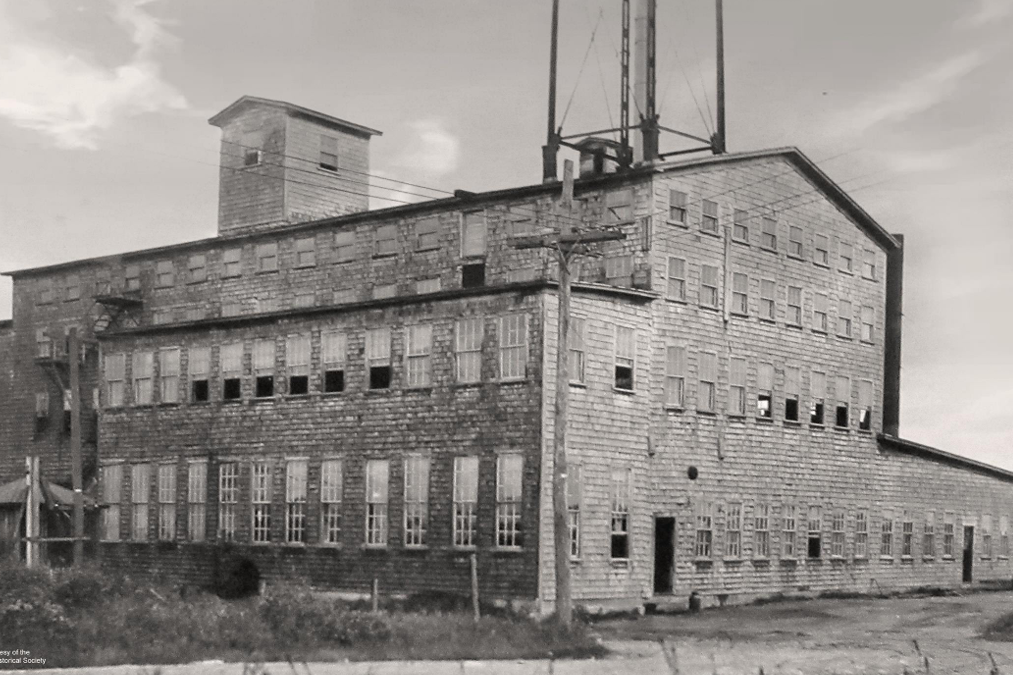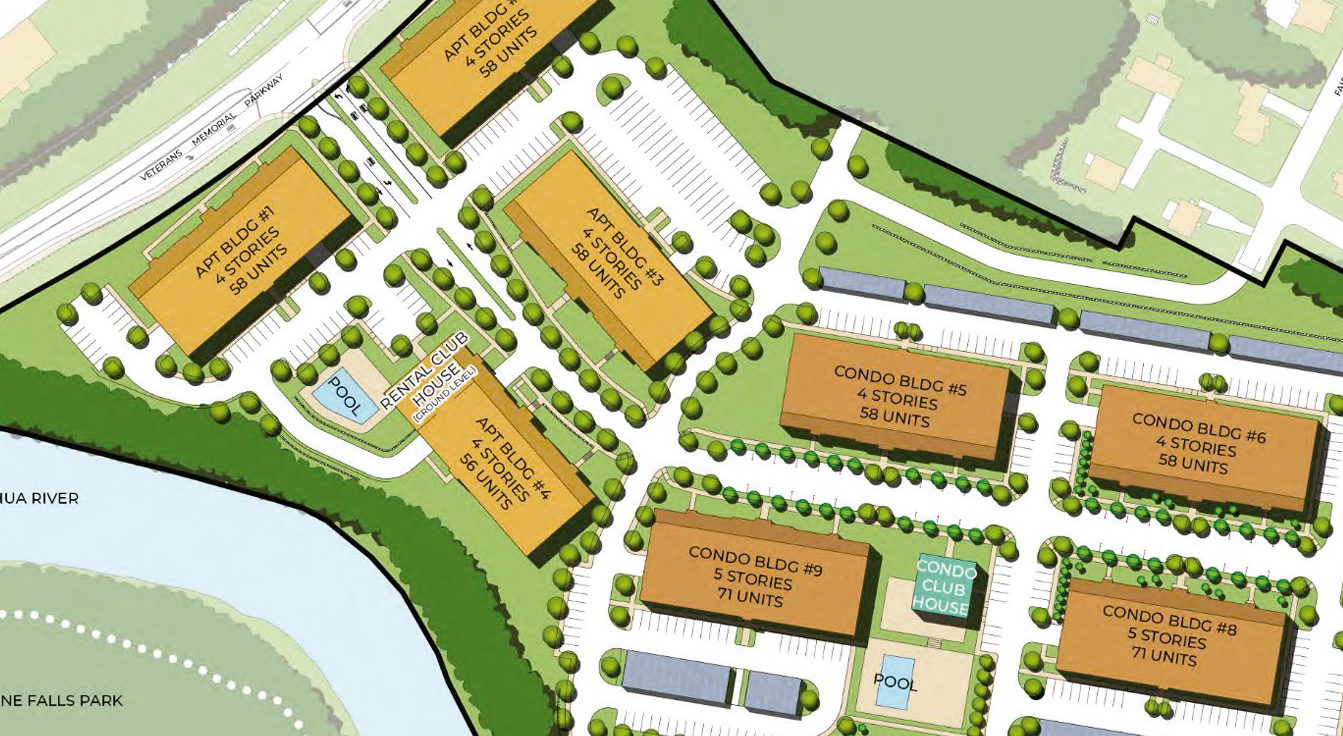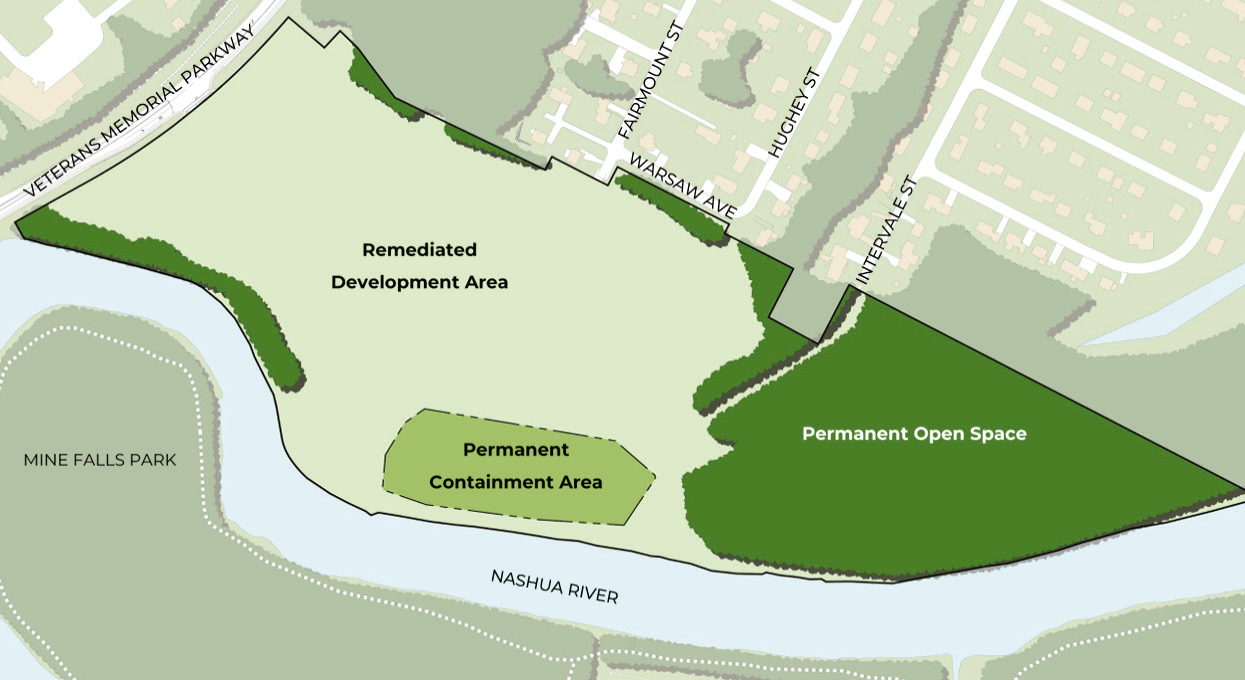Mohawk Tannery/Fimbel Door redevelopment project slated for 546 apartments, condominiums and more

An undated photo of the main building at Mohawk Tannery, which operated along the Nashua River from 1924-1984. The final building at the site was torn down in 2012, after the final of many arson fires at the vacant site. (Courtesy of Blaylock Holdings) The first redevelopment stops for a plan that will include 546 housing units at a former industrial site that has gone through an extensive cleanup in recent years will go before the Nashua Planning Board on Feb. 15.
The Mohawk Tannery/Fimbel Door Redevelopment project by Blaylock Holdings LLC calls for 546 apartments and condominiums, as well as green space and a resident recreation area that includes a canoe and kayak launch. A conceptual plan from last year also shows a pedestrian bridge across the Nashua River to Mine Falls Park.
The Planning Board will consider three subdivision applications for the site at the Feb. 15 meeting. The items were moved from the Feb. 1 agenda.
The redevelopment portion of the project begins as a $14.3 million cleanup of the tannery site is underway. The cleanup must be approved by the U.S. Environmental Protection Agency before construction can begin.
The 40-acre site is bordered by Veterans Memorial Parkway, the Nashua River and the Fairmount Heights neighborhood. It’s across the river from Mine Falls Park. Current owners of sites affected by the development are the city of Nashua, Fimbel Door Corp., Chester Realty Trust, J.K.S. Realty LLC and L.J.J. Realty LLC. Blaylock Holdings is the developer.
The development area includes the 30.54-acre former Mohawk Tannery Site, which is owned by Chester Realty Trust; the 4.98-acre Fimbel Door Corp. site and the 4.4-acre Row parcel between Fimbel Door and the parkway.
The development’s proposed nine buildings would house 230 apartments in four four-story buildings next to Veterans Memorial Parkway and 316 condominiums in five four- and five-story buildings in the center of the site, according to a conceptual plan shown to area residents last March.
Phase I of the construction, beginning with the planning board approvals, would last through early 2026. By the end of 2025, there would be 57 completed apartments and 63 completed condo units at the site. There would be 172 apartments by the end of 2026, and a complete 230 by the end of 2027. The condo development would progress more slowly, with about 60-70 a year until all 316 are completed in 2030, according to the conceptual plan.
Blaylock will make a contribution of $2.3 million to the Nashua Affordable Housing Trust Fund and 20% of the apartments will be affordable housing, according to the conceptual plan.
Estimated annual property taxes would be about $1.9 million in 2029, the first year of full buildout, according to the 2023 presentation.
Some 10 acres along the river will be given to the city for new green space. The pedestrian bridge, which Mayor Jim Donchess refers to as a “future dream” in an August online post, would be financed by a $3 million bond issue.
The Planning Board will consider three subdivision applications for the site, including:
Subdivision of a portion of Veterans Memorial Parkway, zoned RC (urban residence), RB (urban residence) and VMPR (Veterans Memorial Parkway Redevelopment Overly District), owned by the city.
Proposed two-lot subdivision at Fairmount Street, Zoned RC, RB and VMPR Urban Residence, and VMPR.
Proposed consolidation of seven existing lots and subdivide into nine proposed lots along with a proposed public road at Fox Street, 66 Fairmount Street, 11 Warsaw Avenue, Intervale Street, Hughey Street and Fairmount Street; zoned RC Urban Residence, RB Urban Residence, and VMPR Veterans Memorial Parkway Redevelopment Overly District.
The site plan for the Mohawk Tannery Redevelopment project including the Mohawk, Fimbel Door and portions of other property into a total of 546 multi-family residential units, along with associated site improvements.
EPA, Blaylock, city partner on cleanup
Mohawk Tannery occupied the 30.58-acre site on the banks of the Nashua River 1924 to 1984, producing tanned hides for leather. The owners gave little thought to the toxic nature of the waste they dumped with abandon in lagoons right next to the river, and in the river itself. In the 40 years since it’s closed, it’s remained a vacant, fenced-in hazardous oasis in the heart of Nashua as the U.S. Environmental Protection Agency worked on getting it cleaned up. It became the EPA’s Granite State Leathers Superfund Site.
The EPA announced an agreement in February 2021 with Blaylock Holdings to clean up and develop the site after more than two years of public hearings and negotiation. The $14.3 million cleanup was funded with $6 million from the EPA, a $3 million New Hampshire Business Finance Authority loan, a $2 million city of Nashua loan financed by the BFA, and $3.3 million in private equity raised by Blaylock.
At the time the cleanup was announced, the EPA called it a “unique” cost-sharing arrangement that will save $8 million in “taxpayer’s money,” as compared to EPA performing the cleanup by itself. The cleanup was designed to address hazardous substances in soil and sludge, as well as waste originating from the site and “once completed, will eliminate the threat posed to human health and the environment.”
The 4.98-acre Fimbel Door property is also considered environmentally sensitive and will also be made safe as part of the redevelopment project.
The Mohawk Tannery dumped waste in lagoons that were yards from the Nashua River, as well as in a series of pits and drainage basins in and around the tannery buildings, the EPA said.
“The sludge and the soils in these areas are contaminated with heavy metals, semi-volatile organic compounds and/or dioxins,” the EPA said. The agency also determined that there was asbestos in the soil.
“These contaminants are presently exposed in the open lagoon and surficial soils in various locations at the site,” the agency’s assessment of the site before the current cleanup said. “Most of the waste lies in the northern parcel in the former lagoons adjacent to the Nashua River.”
A March 2023 power point shown at a community meeting about the project includes a 1976 clipping from the Nashua Telegraph detailing Mohawk’s struggles to find an environmentally friendly way to get rid of the toxic sludge the plant produced.
Eight years later, in May 1984, after a variety of lawsuits from residents and organizations, the EPA filed suit against the tannery’s owners. The tannery closed, and the 30 acres along the river remained a vacant toxic site.

A conceptual rendering shows eight of the nine apartment and condominium buildings planned for the former Mohawk Tannery and Fimbel Door Corp. sites in Nashua. Conceptual renderings are not final site plans, and may change before a project is approved. (Image by Blaylock Holdings)

A rendering points out elements including a kayak/canoe launch on the Nashua River and proposed pedestrian bridge to Mine Falls Park. (Courtesy of Blaylock Holdings)

A map shows the areas of the Mohawk Tannery redevelopment project, which includes cleanup of hazardous waste left by the tannery that once operated there. (Courtesy of Blaylock Holdings)
The EPA from 2000-2002 cleaned up asbestos and other hazardous material at the site, and continued to work with the owners on keeping the hazardous waste there from becoming more of a problem.
The site was proposed for the National Priorities List in 2000 because of the tannery had discharged wastewater containing hazardous substances such as chromium, zinc, and phenol directly into the Nashua River, and disposed of sludge containing hazardous substances such as chromium, pentachlorophenol, phenol, and 2,4,6-trichlorophenol into unlined disposal areas at the site.
The site was never added to the list, at the city’s request, because of its potential as a development site, according to the EPA history of the site. The rational presumably, was that a developer would shoulder part of the escalating cleanup cost. In 2018, nearly 20 years after it was proposed for the list, but not included, Blaylock, the city and the EPA began discussing the development project, with the agreement announced in December 2021.
Before the agreement was reached, residents at public comment sessions worried that proposed mitigation procedures wouldn’t be enough, and the site would not be safe for residents. The EPA said at the time that totally removing all contaminants would cost more than $32 million.
The Blaylock cleanup comprises excavating hazardous tannery waste, landfill material and asbestos-containing material; disposal of waste in a newly constructed waste containment cell, and general property restoration. The containment cell will use “the most advanced materials and technology, including an impermeable cap and vertical barrier designed to meet EPA requirements under the Comprehensive Environmental Response, Compensation, and Liability Act, the National Oil and Hazardous Substances Pollution Contingency Plan (NCP), and the overall cleanup plan,” the EPA said.
Over the decades the site has been vacant, despite fencing, it’s been vandalized, trespassed on and burned. The building at the site wasn’t razed until 2012, after the final of several arson fires.
“This cleanup and redevelopment will reduce risk to human health and the environment and provide significant economic opportunity, much needed residential housing and bring an otherwise abandoned property back into productive use,” the EPA says in a fact sheet about the cleanup history of the site.
This article is being shared by partners in The Granite State News Collaborative. For more information, visit collaborativenh.org.
The EPA called it a ‘unique’ cost-sharing arrangement that will save $8m in ‘taxpayer’s money.’